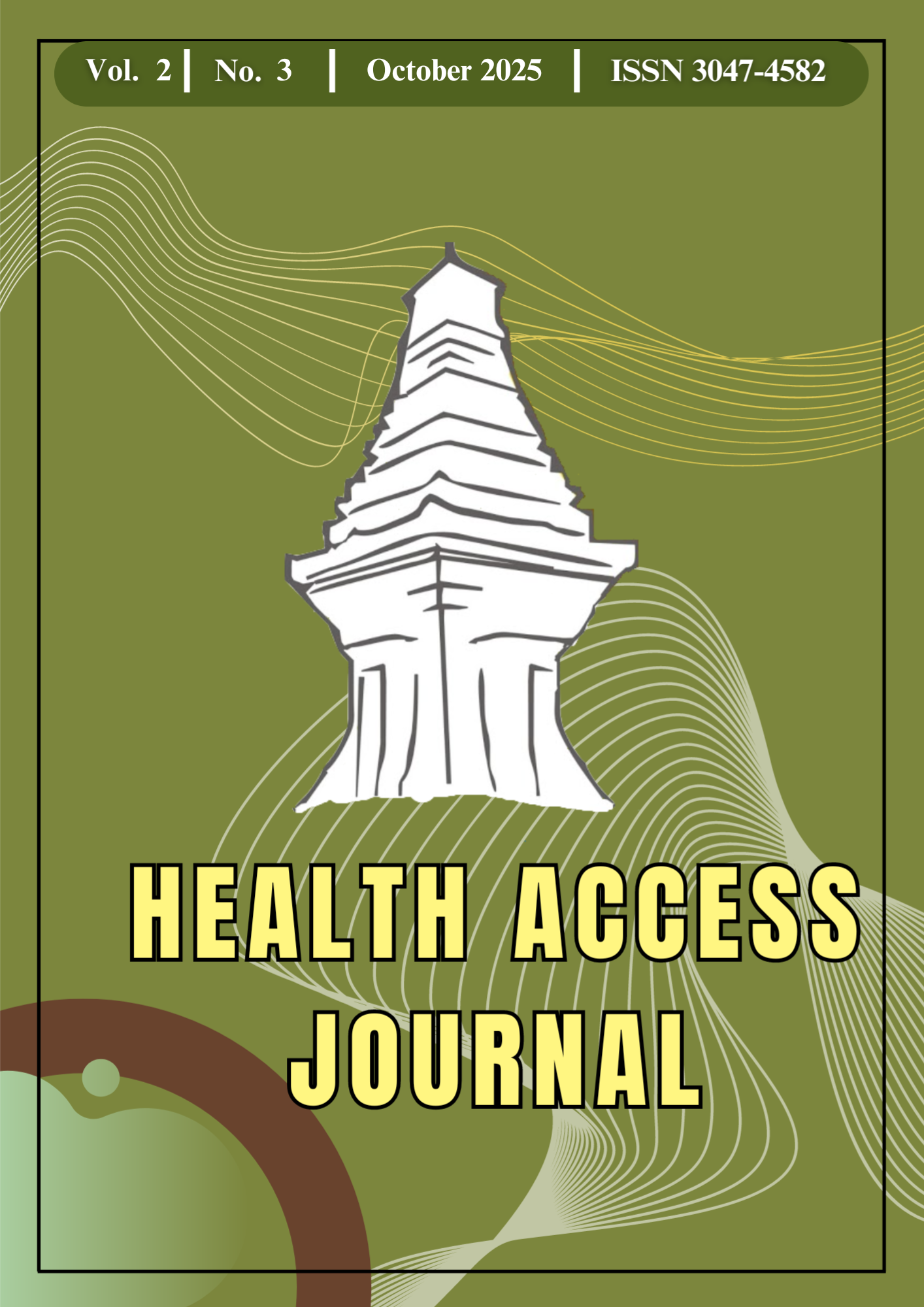Acceptance of Teledermatology Among Primary Health Care Workers in Isabela
DOI:
https://doi.org/10.31290/haj.v2i3.5550Keywords:
Teledermatology, modified technology acceptance model, primary health care workersAbstract
Teledermatology is emerging as a means of delivering healthcare service to remote areas. In the context of the full implementation of the Universal Health Care, dermatological services can be given to those in the primary care facilities. This study explores the acceptance of teledermatology among primary healthcare workers in Isabela, Philippines, focusing on technological, individual, and organizational factors influencing adoption. Guided by the modified Technology Acceptance Model (TAM), the research evaluates constructs such as perceived usefulness, perceived ease of use, attitude, compatibility, facilitators, subjective norms, and habitual use. A structured survey was administered to 87 purposively selected healthcare professionals, including nurses, midwives, doctors, and barangay health workers. Findings reveal that perceived usefulness and attitude significantly influence intention to use. Younger professionals and nurses exhibited higher acceptance levels, whereas gender and years of service were not significant factors. Despite positive perceptions, challenges remain in habitual use, underscoring the need for reliable internet access, administrative support, and ongoing training. The study affirms the relevance of TAM in this context and highlights the importance of targeted interventions to support sustainable teledermatology integration in primary care settings. In conclusion, this study highlights the acceptance of teledermatology among primary health care workers in Isabela.
References
REFERENCES
Angeles, C., Chavez, C., Lim, H., Guevara, B., & Jamisola, L. (2021b). Impact of the COVID?19 pandemic on Dermatology Practice in the Philippines: A cross?sectional study. Australasian Journal of Dermatology, 62(4). https://doi.org/10.1111/ajd.13714
Cuenca, A. C. L., Visitacion, L. R., & Segovia, J.-C. L. Q. (2022). Teledermatology at a tertiary government hospital in Davao City during the COVID-19 pandemic: A retrospective descriptive study. Journal of the Philippine Dermatological Society, 31(1), 1–6.
Lucero-Orillaza, H. E. (2021). Teledermatology: The New Normal? Acta Medica Philippina, 55(5), 487–488.
Salazar Paraz, MD (2020). The Effectiveness of a Three-hour Online Dermatology Didactic Course on the Dermatologic Knowledge of of Doctors-to-the- Barrio (DTTBs): A Quasi-Experimental Pilot Study.
Champagne, T., Rossos, P. G., Kirk, V., & Seto, E. (2018). Impact of an intrainstitutional teledermatology service: Mixed-methods case study. JMIR Dermatology, 1(2).
Bianchi, M. G., Santos, A., & Cordioli, E. (2020a). Benefits of teledermatology for geriatric patients: Population-based cross-sectional study. Journal of Medical Internet Research, 22(4). https://doi.org/10.2196/16700
Taslidere, N., & Kucuk, O. S. (2023). Investigation of the effectiveness of teledermatology in the diagnosis of skin lesions in pediatric patients. Revista Da Associação Médica Brasileira, 69(10). https://doi.org/10.1590/1806-9282.20230253
López-Liria, R., Valverde-Martínez, M. Á., López-Villegas, A., Bautista-Mesa, R. J., Vega- Ramírez, F. A., Peiró, S., & Leal-Costa, C. (2022). Teledermatology versus face-to-face dermatology: An analysis of cost-effectiveness from eight studies from Europe and the United States. International Journal of Environmental Research and Public Health, 19(5), 2534. https://doi.org/10.3390/ijerph19052534
Gao, J. L., & Oakley, A. (2023). Teledermatology for enhancing skin cancer diagnosis and management: Retrospective Chart Review. JMIR Dermatology, 6. https://doi.org/10.2196/45430
Orruño, E., Gagnon, M. P., & Asua, J. (2011). Evaluation of teledermatology adoption by healthcare professionals using a modified Technology Acceptance Model. Journal of Telemedicine and Telecare, 17(6), 303–307. https://doi.org/10.1258/jtt.2011.101101
Sendín-Martín, M., Jiménez-Zarco, A., Saigí-Rubió, F., Conejo-Mir, J., & Pereyra-Rodriguez, J. J. (2019). Determinants of the intention to use teledermatology: Evidence from dermatologists and Primary Care Physicians. JMIR Dermatology, 2(1). https://doi.org/ 10.2196/14459
Kamal, S. A., Shafiq, M., & Kakria, P. (2020). Investigating acceptance of telemedicine services through an extended technology acceptance model (TAM). Technology in Society, 60, 101212. https://doi.org/10.1016/j.techsoc.2019.101212
AlQudah, A. A., Al-Emran, M., & Shaalan, K. (2021). Technology acceptance in Healthcare: A systematic review. Applied Sciences, 11(22), 10537. https://doi.org/10.3390/app112210537
Parial, L. L. B., Leyva, E. W. A., Siongco, K. L. L., Dones, L. B. P., Bernal, A. B. S., Lupisan, J. A. C., Santos, D. C., Diamaoden, M. M. C., & Bonito, S. R. (2024). Staffing and workload in primary care facilities of selected geographically isolated and disadvantaged communities in the Philippines. Acta Medica Philippina, 58(12). https://doi.org/10.47895/amp.v58i12.9268
Abrigo, M. R. M., & Ortiz, D. A. P. (2019). Who are the health workers and where are they? Revealed preferences in location decision among health care professionals in the Philippines. Philippine Institute for Development Studies Discussion Paper Series, 2019(32).
Klaz, I., Wohl, Y., Nathansohn, N., Yerushalmi, N., & Sharvit, S. (2005). Teledermatology: Quality assessment by user satisfaction and clinical efficiency. Israel Medical Association Journal, 7(8), 502–505. https://www.ima.org.il/filesupload/IMAJ/0/50/25307.pdf
Zakaria, A., Maurer, T., Su, G., & Amerson, E. (2019). Impact of teledermatology on the accessibility and efficiency of dermatology care in an urban hospital: A pre-post analysis. Journal of the American Academy of Dermatology, 81(2), 323–330.
Jiménez-Zarco, A., Saigí-Rubió, F., & Sendín-Martín, M. (2019). Determinants of the intention to use teledermatology: Evidence from dermatologists and primary care physicians. JMIR Dermatology, 2(1), e14459. https://doi.org/10.2196/14459
Coustatte, A., Sarkar, R., & Abodunde, B. (2019). Use of teledermatology to improve dermatological access in rural areas. Telemedicine and e-Health, 25(3), 230–237.
Dowling, K. H. (2020). Exploring perceptions of teledermatology among primary care providers in rural Mississippi. ProQuest Dissertations & Theses Global.
Giansanti, D. (2023). Advancing dermatological care with teledermatology and mHealth: Bridging gaps and expanding opportunities beyond COVID-19. Healthcare, 11(13), 1911.
Acoba, J. B. M., Genuino, R. F., Dim-Jamora, K. C. C., Jamora, M. J. J., & Sison, A. C. (2023). Knowledge, attitudes, and practices on teledermatology among dermatologists in the Philippines. Journal of the Philippine Dermatological Society, 32(2), 83–89.
Reinders, P., Augustin, M., Fleyder, A., & Otten, M. (2024). Exploring acceptability, barriers, and facilitators for digital health in dermatology: Qualitative focus groups with dermatologists, nurses, and patients. JMIR Dermatology, 6(1), e57172.
Janda, M., Horsham, C., Koh, U., & Gillespie, N. (2019). Evaluating healthcare practitioners' views on store-and-forward teledermoscopy services for the diagnosis of skin cancer. Digital Health. https://doi.org/10.1177/2055207619828225
Dash, M., Mohanty, A. K., & Das, J. R. (2016). Physician's acceptance of teledermatology services: An empirical study. International Journal of Engineering Management & Economics. https://www.academia.edu/download/46153398/25-29.pdf
Tensen, E., Van Der Heijden, J. P., & Jaspers, M. W. M. (2016). Two decades of teledermatology: Current status and integration in national healthcare systems. Current Dermatology Reports, 5(2), 96–104. https://doi.org/10.1007/s13671-016-0136-7
Miao, V. Y. (2024). Teledermatology for rural areas: Experiences and perspectives of Australian dermatologists and dermatology trainees. Australasian Journal of Dermatology 65.
Stratton, D., & Loescher, L. J. (2016). The acceptance of mobile teledermoscopy by primary care nurse practitioners in the state of Arizona. Journal of the American Association of Nurse Practitioners, 28(6), 302–309. https://doi.org/10.1002/2327-6924.12313
Dash, M., Shadangi, P. Y., & Mohanty, A. K. (2019). A conceptual model for telemedicine adoption: An examination of the technology acceptance model. International Journal of Recent Technology and Engineering. https://doi.org/10.35940/ijrte.B1916.078219
Maul, L. V., Jahn, A. S., Pamplona, G. S. P., & Streit, M. (2023). Acceptance of telemedicine compared to in-person consultation from the providers' and users' perspectives. JMIR Dermatology, 6(1), e45384. https://doi.org/10.2196/45384
Downloads
Published
How to Cite
Issue
Section
License
Copyright (c) 2025 Louella Fatima Ramos Bascos

This work is licensed under a Creative Commons Attribution-ShareAlike 4.0 International License.









-fococlipping-standard.png)









